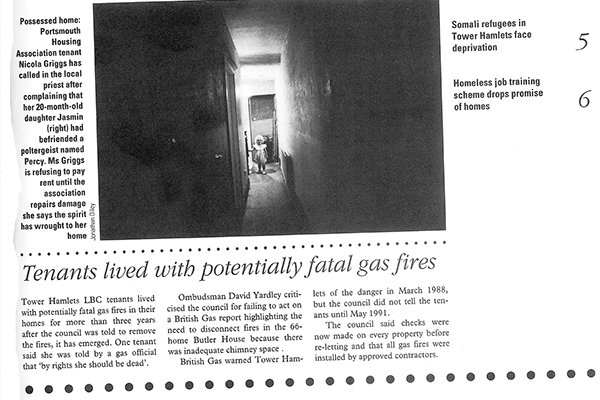You are viewing 1 of your 1 free articles
From the archive: concerns over gas fires
Inside Housing looks back at what was happening in the sector this week five, 15 and 25 years ago
25 years ago
Tower Hamlets tenants lived with potentially fatal gas fires in their homes for more than three years after the council was told to remove them, Inside Housing reported on its front page (see below)
One tenant was told by a gas official that “by rights she should be dead”, the magazine reported.
Ombudsman David Yardley criticised the council for failing to act on a British Gas report highlighting the need to disconnect fires in 66-home Butler House because of inadequate chimney space.
British Gas warned Tower Hamlets of the danger in March 1988, but Inside Housing reported that the council did not tell the tenants until May 1991.
The council said checks were now made on every property before re-letting and that all gas fires were installed by approved contractors.
15 years ago
Councils needed to think beyond flashy websites and use technology to drag housing services into the 21st century, Inside Housing reported in an interview with Valerie Shawcross – then working for London mayor Ken Livingstone as ‘e-envoy’. (She is now back in City Hall as deputy mayor for transport under Sadiq Khan.)
“I’m not a techie,” Ms Shawcross told Inside Housing, before pointing out that technology was relegated to a “techie-nerd geeky ghetto” for IT managers to think about. Instead chief executives and cabinet members should be thinking about how to use IT to improve their services.
She had set up an ‘e-agency’ for London boroughs, to help them achieve economies of scale when commissioning IT. A new, internet-based application allowed councils and housing associations to share information on housing benefit easily, rather than associations waiting to phone the council when they were open – in the case of Bromley at the time, this was between the hours of 10am and 2pm.
“It seems we are 20 years behind where we could be,” Ms Shawcross concluded.
Five years ago
Social networking was slowly becoming mainstream practice, Inside Housing reported, with increasing numbers of organisations using Facebook and Twitter.
Landlords were offering staff corporate Twitter accounts and encouraging them to set up Facebook pages. Landlords said they were using social media to connect with tenants, particularly those unlikely to respond in other ways. Halton Housing used it to connect with young people who only checked their emails at work.
Inside Housing ran a league table of landlords – and individuals within the sector – with the biggest Twitter following, topped by Bromford, which then had 1,053 followers (5,066 today), and its innovation coach Paul Taylor (below) – who then had 2,667 followers (21,800 today).










